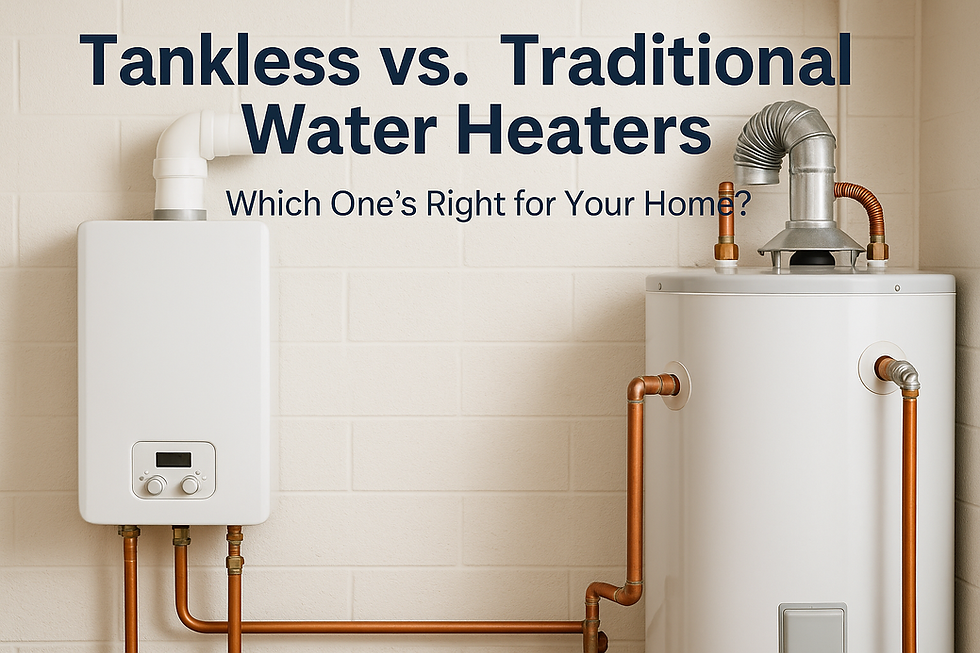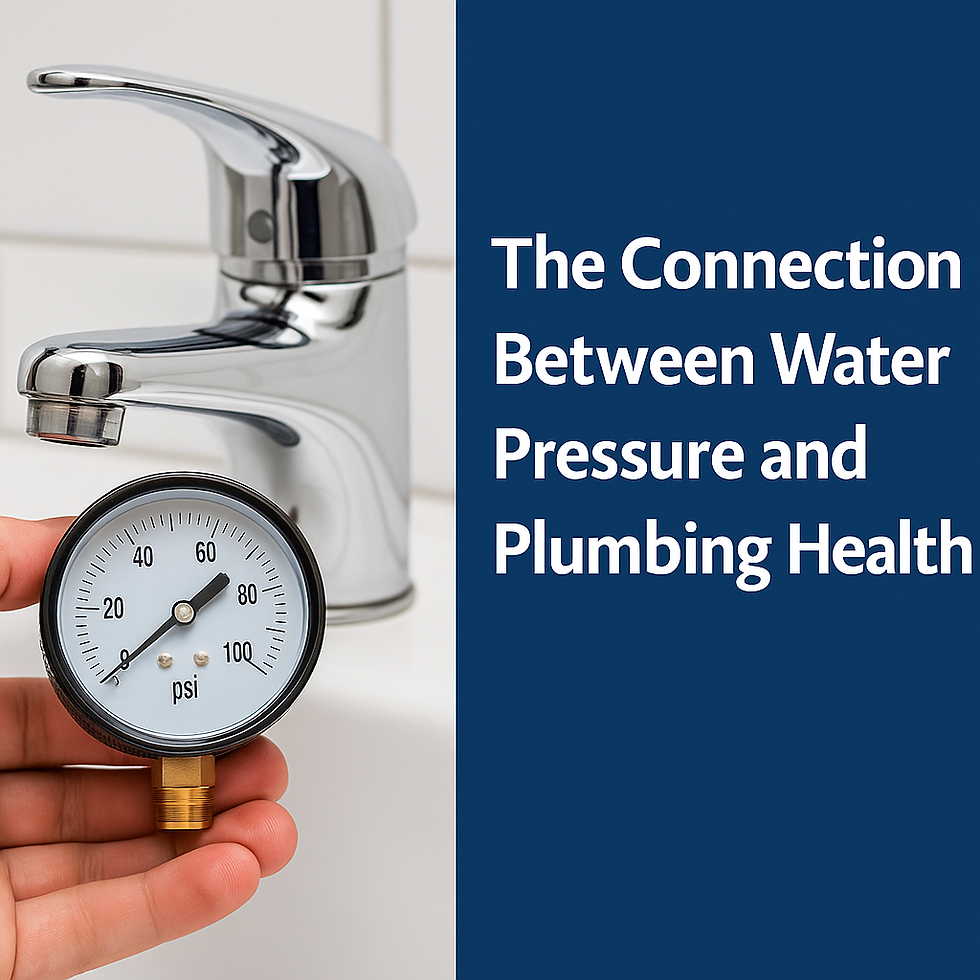Tankless vs. Traditional Water Heaters: Which One’s Right for Your Home?
- Oliver Owens
- Aug 8
- 4 min read
If you’ve ever been the last one in line for a shower and ended up with nothing but cold water, you know exactly how frustrating it can be. In Placentia, mornings can mean back-to-back showers, the dishwasher running, and a load of laundry all going at once—which makes running out of hot water feel almost inevitable.

When it’s time to replace your water heater, you’re really looking at two main choices: tankless (on-demand) or traditional (storage tank). Both can deliver the hot water you need, but they work in completely different ways. The right choice comes down to how you use hot water, how much you use, and what you expect from your system.
Here’s a breakdown—no pushy sales pitch, no confusing jargon—just straightforward facts and a little local know-how from your neighbors at Kramer’s Plumbing.
How They Work (Quick Overview)
Traditional Water Heaters
These are the big insulated tanks you’ve probably seen in a garage or closet. They heat and store a set amount of water—usually 30–50 gallons—so it’s ready when you need it. Once the stored supply is gone, you’ll wait for the tank to refill and reheat before you can enjoy another hot shower.
Tankless Water Heaters
Also called “on-demand” systems, these skip the storage tank entirely. They heat water only when you turn on the tap and send it directly to you. There’s no waiting for a refill—just a steady stream of hot water for as long as the system can keep up.
Traditional Water Heaters: Pros & Cons
What We Like:
Simple, proven design with fewer parts that can break.
Replacement is usually straightforward.
Predictable hot water supply—until it runs out.
Things to Consider:
Once empty, you’ll wait for it to heat back up.
Uses energy 24/7 to keep water hot, even when you’re not home.
Shorter lifespan—typically 8–12 years with good maintenance.
Tankless Water Heaters: Pros & Cons
What We Like:
Endless hot water—perfect for busy mornings.
More energy-efficient since it heats water only when needed.
Often lasts 15–20 years with proper care.
Small, wall-mounted design saves space.
Things to Consider:
Needs to be correctly sized for your household demand.
Multiple showers and appliances at once can max it out.
Installation may require gas, venting, or electrical upgrades.
Which One Fits Your Home?
When we help Placentia homeowners decide, we look at three main factors: household size, usage patterns, and timing.
Household Size
1–2 people: Tankless is often ideal—compact and efficient.
Larger families: Tankless still works well if it’s sized for multiple users.
Flexible schedules: A traditional tank works fine if you can stagger hot water use.
Usage Patterns
Morning rush hour: Tankless can handle back-to-back use.
Spread-out use: Traditional tanks are fine and limit standby energy loss.
Heavy simultaneous use: Consider a larger tank or more than one tankless unit.
Lifestyle Factors
Staying long-term: Tankless can pay off with longer life and energy savings.
Moving soon: A new traditional tank is a quick, functional upgrade for resale.
Why Placentia’s Climate Helps
Here in Southern California, incoming water isn’t icy cold like it is up north. That means tankless systems don’t have to work as hard to heat it, making them more efficient.
We also don’t deal with freeze-related plumbing issues that can limit installation options in colder climates. That gives you more flexibility with both tank and tankless placement—garage, utility room, or even outdoors with minimal protection.
Maintenance: What to Expect
Traditional Tanks
Flush yearly to remove sediment buildup.
Replace the anode rod every few years to prevent rust.
Once the tank itself leaks, it’s replacement time.
Tankless Systems
Flush or descale every 1–2 years to prevent mineral buildup (important with Placentia’s hard water).
Clean built-in filters as needed.
Check venting and connections annually.
The Environmental Angle
If you’re aiming to shrink your energy footprint, tankless usually wins. By heating water only when you need it, it avoids the constant standby heat loss of a traditional tank.
The U.S. Department of Energy says tankless systems can be 24–34% more efficient for homes using under 41 gallons of hot water daily. (Here’s their Water Heating Guide if you want to dig deeper.)
Cost Over Time
A traditional tank is less expensive to install, but you might replace it twice in the time one tankless system lasts. Tankless units have a higher upfront cost, but their efficiency and long lifespan often make them more economical over the years—especially in our mild climate.
Common Myths, Busted
“Tankless means instant hot water.” Not quite—you’ll still wait a few seconds for it to travel through the pipes, but it won’t run out once it starts.
“Traditional tanks waste water.” They don’t waste water, but they do waste energy keeping it hot.
“Tankless can’t handle big families.” It can—if it’s sized correctly or paired with a second unit.
Local Tip: Protect Against Hard Water
Placentia’s moderately hard water can shorten the lifespan of any water heater. In traditional tanks, sediment settles at the bottom, reducing efficiency. In tankless systems, mineral buildup slows heating.
Pairing your water heater—tank or tankless—with a water softener is one of the best investments you can make. It protects your plumbing, keeps your system efficient, and even helps dishes and laundry come out cleaner.
Real-World Example
A Placentia family with a 12-year-old tank heater was constantly running out of hot water during the morning rush. Sediment buildup was clearly part of the problem. We replaced it with a properly sized tankless unit and added a water softener. Now, two showers and the dishwasher can run at the same time—no drop in temperature. Plus, the extra storage space in their utility room was a nice bonus.
The Kramer’s Plumbing Take
We’ve installed and serviced both systems in homes across Placentia. There’s no universal “best” choice—the right water heater is the one that fits your home’s needs, your lifestyle, and your expectations.
Our job isn’t to push the priciest option—it’s to help you choose the one that works for you. Whether that’s a reliable, high-efficiency tankless unit or a solid traditional tank, we’ll install it right and keep it running for years to come.
.png)





Comments